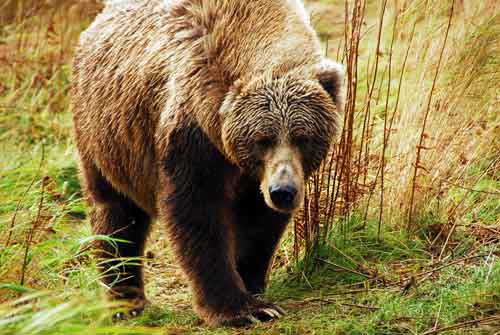 By Ned Rozell March 30, 2007
Sandy Talbot and Kevin Sage from the genetics lab showed that Kodiak brown bears are less genetically diverse than other brown bears in North America. They also confirmed biologists' observations that male bears seem to wander over the island while females stick to what they know.  Photo by Mara Weisenberger, U.S. Fish and Wildlife Service.
The scientists also found that brown bears on Kodiak and nearby Afognak islands are distinct populations, meaning that few bears are swimming between the islands, which are about four miles apart at the closest point. Swans Since 1968, Fish and Wildlife Service biologists have counted trumpeter swans every five years in Alaska. From a low of 2,847 swans in 1968, numbers of the large white birds increased to 23,692 in the 2005 survey. This is despite a huge recent die-off of swans in their wintering grounds in northwestern Washington and southwestern British Columbia, possibly due to lead poisoning from shotgun pellets. Why are trumpeter swans doing so well in Alaska? They might be responding to a longer ice-free period up here, according to biologist Mark Lindberg of the University of Alaska Fairbanks and Josh Schmidt, a graduate student who has been looking at trumpeter swan numbers. To fledge their young, trumpeter swans need about five months when breeding lakes have no ice, Lindberg said. A warmer climate might be providing that. "I suspect that five months of ice free conditions has only recently come to parts of Alaska where trumpeters are now breeding; the Interior and north of the Arctic Circle," Lindberg said. Ants Ken Philip says ants aren't really the muscle-bound insects people trump them up to be. And he should know. Philip and his helpers have built up a vast collection of northern butterflies that will someday belong to the Smithsonian Institution. He called to dispel the notion that the mighty ant's strength is superior to yours. The myth is born, no doubt, from people seeing ants carrying objects bigger than they are. But tiny humans would be even stronger than ants, Philip said. "The strength of a muscle is equal to its cross-sectional area," Philip said. "The weight of an animal is proportional to the cube of its linear size and the strength is proportional to the square. If you reduced a human by a factor of 200, about the size of an ant, he could lift 200 times his own weight. A human being the size of an ant could lift a scaled-down tractor-trailer." Lynx Yoram Yom-Tov of the Zoology Department of Tel Aviv University in Israel recently measured 555 lynx skulls at the University of Alaska Museum of the North. He wanted to see if a warmer Alaska affected the size of lynx. Instead, he found something else. After measuring the skulls of lynx taken by trappers in the last 50 years, Yom-Tov wrote to Howard Golden of the Alaska Department of Fish and Game for trapping records and found that lynx were smaller in years when there were many lynx. Their decreased size might be due to increased competition for their favorite food-snowshoe hares, he said. Yom-Tov also spent hours measuring Alaska marten and masked shrew skulls, and found that they both seem to be getting larger in the last 50 years, possibly because the animals put energy into growth that they formerly used to survive a longer winter.
Ned Rozell [nrozell@gi.alaska.edu] is a science writer at the institute. Publish A Letter on SitNews Read Letters/Opinions
|